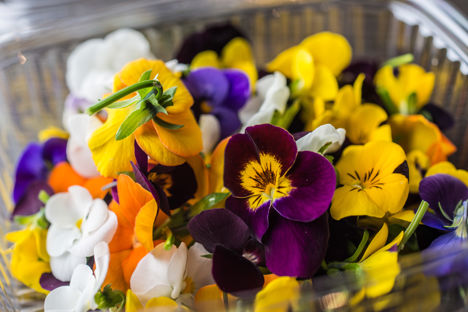
Cooking with flowers
With spring now officially upon us, and Mother’s Day on Sunday, we called on the expertise of Pascal Aussignac to explore the options of cooking with flowers.
Cooking with flowers
With spring now officially upon us, and Mother’s Day on Sunday, we called on the expertise of Pascal Aussignac to explore the options of cooking with flowers.
“I saw a French programme, very late at night – I couldn’t sleep so I switched on the TV… it was a kind of peasant, countryman, who was cutting flowers, tulips, and saying you could eat them. They were organic. And I said, ‘That’s very interesting,’”
Inspired by a little serendipity, Pascal Aussignac has become renowned for using flowers in his cooking, wowing diners at his restaurant, Club Gascon, and watchers of Saturday Kitchen with his ingenious Primavera tulips dish.
“I wanted to go a bit further than just decorating with flowers,” he explains. “That is easy. What is interesting is to really transform the flower… to integrate the flower into your dish.”
Many will recall seeing flowers used to garnish a dish, it’s a trope that extends way back to the age of the seventies dinner party. But, as Pascal explains, it is something else entirely to use the flower as a central part of a dish. Yet that is what Pascal has pioneered - and not just with tulips but gladioli and courgette flowers, too.
Pick a winner
So how can we conjure a pretty dish for Mother’s Day with edible flowers at its heart? Well, according to Pascal, the first thing to do is find out where you can source organic flowers. Cultivated varieties grown for decorative purposes may have been sprayed with all manner of pesticides so are best avoided. As with most ingredients, quality usually equals great flavour and flowers are no exception.
“I was going to the flower market every week during the decoration of the restaurant and I just asked my suppliers where I could get some organic flowers. Most of them were coming from the Italy – the organic ones.”
It is important to do your research about what flowers you can eat before going out to buy (see a few examples below) as some are poisonous. Also consider that different flowers have different flavours and uses so have an idea about what kind of dish you would like to cook before heading to the flower market.
Flowers to use: Violet, nasturtium, tulip, rose, borage, hibiscus, courgette, lavender.
Flowers to avoid: Daffodil, foxglove, wisteria, lily-in-the-valley, crocus.
Cook carefully
Flowers are wonderfully delicate which means they can be a bit of a pain to cook correctly. Pascal recommends the gentle approach of steaming, which he uses himself for his signature dish of Primavera tulips.
“Take out the stamen, put your stuffing (in), close it, steam it with olive oil, and that’s all… 2-3 minutes depending on the thickness of the stem.”
Courgette flowers are also frequently used in Italian cuisine, where they are often stuffed in a similar way to Pascal’s tulips. Yet, Frances Atkins has a recipe on Great British Chefs whereby she deep-fries the flowers in a tempura batter, while Dominic Chapman simply cooks them in the oven. Flowers may be delicate but there are still many options available.
Of course, some flowers do not need to be cooked at all - even if they are the central ingredient. Pascal Aussignac’s wonderful Gladioli dish uses the raw petals as the bed for a spicy violet sauce.
In other instances flowers are used as a flavouring rather than a standout ingredient. Rose petals, for example, can be used to flavour tea, cocktails or even panna cotta.
Pair with care
Flowers are a symbol of springtime and summer and as a general rule should be paired with other seasonal ingredients. Their flavour is usually delicate so be careful not to overpower with overly rich are protein-heavy ingredients. Often petals are used in salads or light vegetarian dishes.
But as Pascal Aussignac has demonstrated, there is no need to keep things safe just because they look so pretty and delicate. The Michelin starred chef recommends taking an experimental approach, pointing out that tulips can be stuffed with anything from leftover fish pie to risotto. He also has an ingenious recipe using baked beans:
“Take out the tomato, the sauce bit, add some fresh tomato, some chopped tomato, for example, some herbs. You can serve it cold.”
Consider the flavour profile of the flower you are using. If you plan on using tulips, which are bang in season, read up on their unique taste – which Pascal compares to wild asparagus – and complement appropriately (other earthy ingredients like mushrooms pair nicely). Similarly if you have violets, which have real perfumed flavour, you might want to match with something softer or creamier like goat’s cheese.


